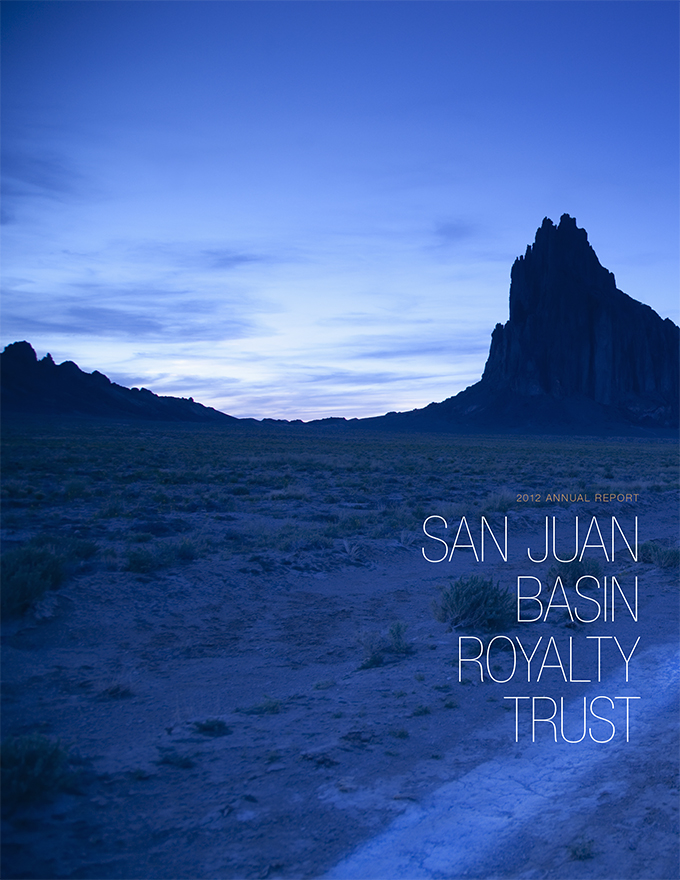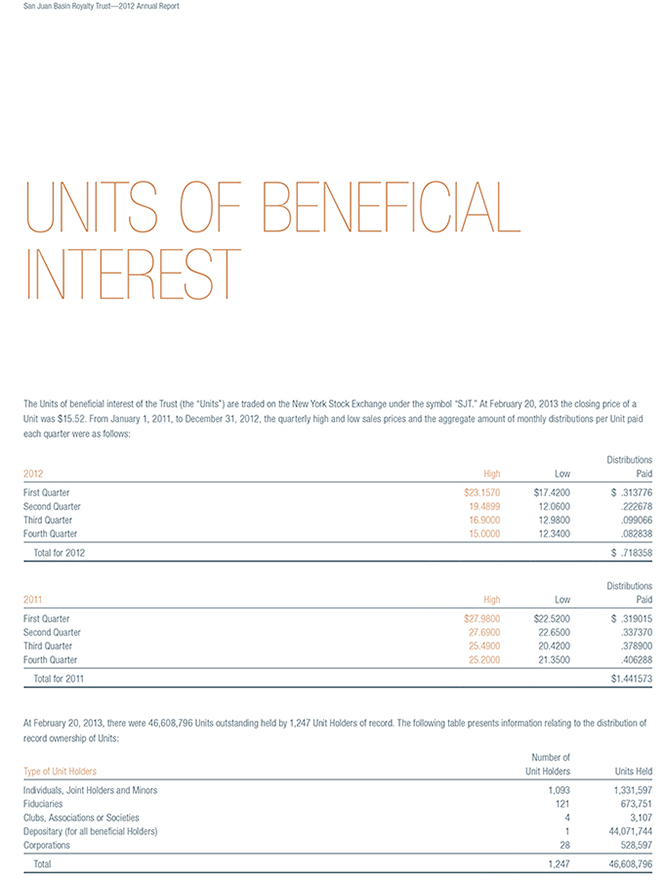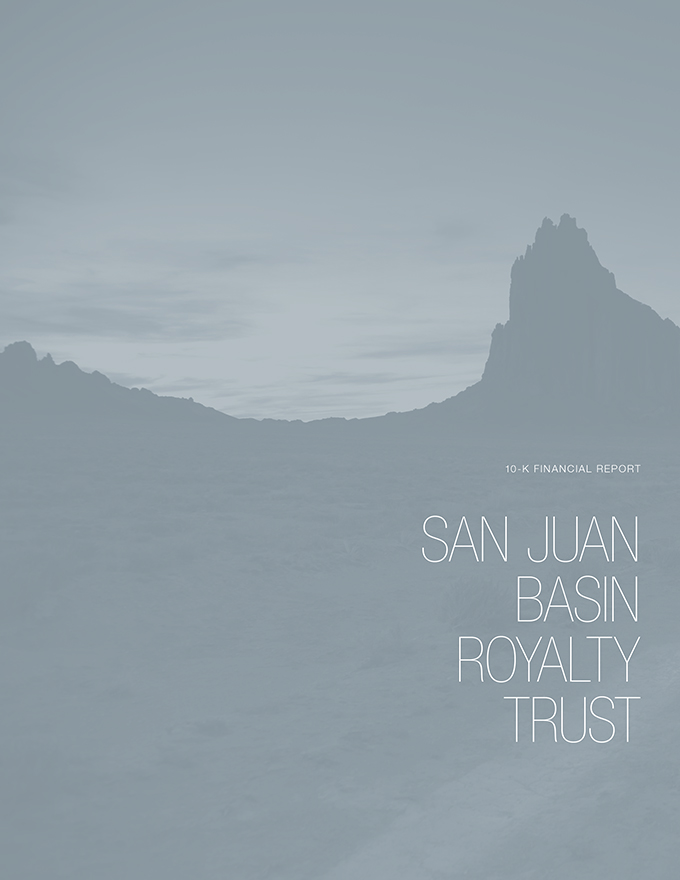
2012 ANNUAL REPORT
SAN JUAN
BASIN
ROYALTY
TRUST

THE TRUST
The principal asset of the San Juan Basin Royalty Trust (the “Trust”) consists of a 75% net overriding royalty interest (the “Royalty”) carved out of certain oil and gas leasehold and royalty interests (the “Underlying Properties”) in properties located in the San Juan Basin of northwestern New Mexico.

2012 Annual Report—San Juan Basin Royalty Trust
TO OUR UNIT HOLDERS
We are pleased to present the 2012 Annual Report of the San Juan Basin Royalty Trust. The report includes a copy of the Trust’s Annual Report on Form 10-K filed with the Securities and Exchange Commission (the “Commission”) for the year ended December 31, 2012, without exhibits. The Form 10-K contains important information concerning the Underlying Properties, as defined below, including the oil and gas reserves attributable to the 75% net overriding royalty interest owned by the Trust. Production figures provided in this letter and in the Trustee’s Discussion and Analysis are based on information provided by Burlington Resources Oil & Gas Company LP (“Burlington”), the current owner of the Underlying Properties and the successor, through a series of assignments and mergers, to Southland Royalty Company (“Southland”). The Trust was established in November 1980 by Southland. Pursuant to the Indenture that governs the operations of the Trust, Southland conveyed to the Trust a 75% net overriding royalty interest (similar to a net profits interest) (the “Royalty”), carved out of Southland’s oil and gas leasehold interests (the “Underlying Properties”) in properties in the San Juan Basin of northwestern New Mexico.
The Royalty constitutes the principal asset of the Trust. Under the Indenture governing the Trust, the function of Compass Bank, as Trustee, is to collect the net proceeds attributable to the Royalty (“Royalty Income”), to pay all expenses and charges of the Trust, and then distribute the remaining available income to the Unit Holders. Income distributed to Unit Holders in 2012 was $33,481,687 or $0.718358 per Unit. Distributable income for 2012 consisted of Royalty Income of $34,485,777 plus interest income of $570,291, less administrative expenses of $1,574,381. Information about the Trust’s estimated proved reserves of gas, including coal seam gas, and of oil as well as the present value of net revenues discounted at 10% can be found in Item 2 of the accompanying Form 10-K.
Certain Royalty Income is generally considered portfolio income under the passive loss rules of the Internal Revenue Code of 1986, as amended. Therefore, Unit Holders should generally not consider the taxable income from the Trust to be passive income in determining net passive income or loss. Unit Holders should consult their tax advisors for further information. Unit Holders of record will receive an annual individualized tax information letter and a Form 1099 for the year ending December 31, 2012. Unit Holders owning Units in nominee name may obtain monthly tax information from the Trust’s Web site or from the Trustee upon request. For the reader’s convenience, a glossary of definitions used in this report can be found on the inside back cover. Please visit our Web site at www.sjbrt.com to access news releases, reports, Commission filings and tax information.
Compass Bank, Trustee
BY: LEE ANN ANDERSON
Vice President and Senior Trust Officer

The principal asset of the Trust is a 75% net overriding royalty interest (the “Royalty”). The Royalty is similar to a net profits interest and it burdens certain of Southland’s oil and gas leasehold interests (the “Underlying Properties”) in properties located in the San Juan Basin of northwestern New Mexico. References below to “gross” wells and acres are to the interests of all persons owning interests therein, while references to “net” are to the interests of Burlington (from which the Royalty was carved) in such wells and acres.
The Underlying Properties consist of working interests, royalty interests, overriding royalty interests and other contractual rights in 151,900 gross (119,000 net) producing acres in San Juan, Rio Arriba and Sandoval Counties of northwestern New Mexico and 4,015 gross (1,158.5 net) wells, calculated on a well bore basis and not including multiple completions as separate wells. Of those wells, 7 gross (5 net) are oil wells and the balance are gas wells. Burlington reports that approximately 839 gross (319.6 net) of the wells are multiple completion wells resulting in a total of 4,854 gross (1,478.1 net) completions.
Production from conventional gas wells is primarily from the Pictured Cliffs, Mesaverde and Dakota formations. ranging in depth from 1,500 to 8,000 feet. During 1988, Southland began development of coal seam reserves in the Fruitland Coal formation. In 2011, Burlington drilled a conventional well which was completed not only to the Mesaverde and the Dakota formations, but also to the Mancos Shale formation which lies between the two. In 2012, Burlington commenced a horizontal well in the Mancos Shale formation. Burlington indicates it will continue to study the Mancos Shale formation and to drill wells intended to be completed to all three of the Mesaverde, Dakota and Mancos Shale formations, but that its program of horizontal drilling activity in the Mancos Shale is uncertain for 2013.
The characteristics of the Pictured Cliffs, the Mesaverde and the Dakota reservoirs result in the wells having very long productive lives. A production index for oil and gas properties is derived by dividing remaining reserves by current production. Based upon the reserve report prepared by the Trust’s independent petroleum engineers as of December 31, 2012, the production index for the Underlying Properties is estimated to be approximately 10.18 years. The production index is subject to change from year to
year based on reserve revisions and production levels and is not presented as an estimate of the life expectancy of the Trust. Among the factors considered by engineers in estimating remaining reserves of natural gas is the applicable sales price for gas. As the sales price increases, the producer can justify expending higher lifting costs and therefore reasonably expect to recover more of the known reserves. Accordingly, as gas prices rise, the production index increases and vice versa.
In addition to gas from conventional wells, the Underlying Properties also produce gas from coal seam wells completed to the Fruitland Coal formation. The process of removing coal seam gas is often referred to as degasification or desorption. Millions of years ago, natural gas was generated in the process of coal formation and absorbed into the coal. Water later filled the natural fracture system. When the water is removed from the natural fracture system, reservoir pressure is lowered and the gas desorbs from the coal. The desorbed gas then flows through the fracture system and is produced at the well bore. The volume of formation water production typically declines with time and the gas production may increase for a period of time before starting to decline. In order to dispose of the formation water, surface facilities including pumping units are required. The price of coal seam gas is typically lower than the price of conventional gas. This is because the heating value of coal seam gas is much lower than that of conventional gas due to (a) ever increasing percentages of carbon dioxide in coal seam gas (carbon dioxide has no heating value), and (b) the absence of heavier hydrocarbons such as ethanes, propanes, and butanes which are present in conventional gas. Furthermore, the processing fees for coal seam gas are typically higher than the processing fees for conventional gas due to the cost of extracting the carbon dioxide.

DESCRIPTION OF
PROPERTIES
In February 2002, Burlington informed the Trust that the New Mexico Oil Conservation Division (the “OCD”) had approved plans for 80-acre infill drilling of the Dakota formation in the San Juan Basin. In July 2003, the OCD approved 160-acre spacing in the Fruitland Coal formation. Eighty-acre spacing has been permitted in the Mesaverde formation since 1997. Burlington is participating in an ongoing study involving test wells completed to the Mesaverde and/or Dakota formations, with some of the test wells drilled on a less than 80-acre spacing basis. In 2009, Burlington drilled and completed a horizontal well in the Fruitland Coal formation on acreage that is burdened by the Royalty. In 2012, the ODC approved 320-acre spacing units for wells completed to the Mancos Shale formation. For well drilled horizontally, multiple units may be combined along the well bore so long as that well bore is perforated in each such unit. While a horizontal well costs more to drill than a more traditional vertical well, the new technology enables the operator to reach additional reserves in areas not fully exploited. Burlington reports it anticipates operating approximately
three drilling rigs in the San Juan Basin during 2013 and that emphasis will be placed on re-working existing wells as distinguished from the drilling of new wells.
The Federal Energy Regulatory Commission is primarily responsible for federal regulation of natural gas. For a further discussion of gas pricing, gas purchasers, gas production and regulatory matters affecting gas production see Item 2, “Properties,” in the accompanying Form 10-K.

San Juan Basin Royalty Trust—2012 Annual Report
UNITS OF BENEFICIAL INTEREST
The Units of beneficial interest of the Trust (the “Units”) are traded on the New York Stock Exchange under the symbol “SJT.” At February 20, 2013 the closing price of a Unit was $15.52. From January 1, 2011, to December 31, 2012, the quarterly high and low sales prices and the aggregate amount of monthly distributions per Unit paid each quarter were as follows:
Distributions 2012 High Low Paid First Quarter $23.1570 $17.4200 $ .313776 Second Quarter 19.4899 12.0600 .222678 Third Quarter 16.9000 12.9800 .099066 Fourth Quarter 15.0000 12.3400 .082838 Total for 2012 $ .718358
Distributions 2011 High Low Paid First Quarter $27.9800 $22.5200 $ .319015 Second Quarter 27.6900 22.6500 .337370 Third Quarter 25.4900 20.4200 .378900 Fourth Quarter 25.2000 21.3500 ..406288 Total for 2011 $1.441573
At February 20, 2013, there were 46,608,796 Units outstanding held by 1,247 Unit Holders of record. The following table presents information relating to the distribution of record ownership of Units: Number of Type of Unit Holders Unit Holders Units Held Individuals, Joint Holders and Minors 1,093 1,331,597 Fiduciaries 121 673,751 Clubs, Associations or Societies 4 3,107 Depositary (for all beneficial Holders) 1 44,071,744 Corporations 28 528,597 Total 1,247 46,608,796

10-K FINANCIAL REPORT
SAN JUAN
BASIN
ROYALTY
TRUST

GLOSSARY OF TERMS
Aggregate Monthly Distribution
An amount paid to Unit Holders equal
to the Royalty Income received by the
Trustee during a calendar month plus
interest, less the general and adminis-
trative expenses of the Trust, adjusted
by any changes in cash reserves.
BBL
Barrel, generally 42 U.S. gallons
measured at 60°F.
BCF
Billion cubic feet.
BTU
British thermal unit; the amount of
heat necessary to raise the tempera-
ture of one pound of water one degree
Fahrenheit.
Coal Seam Well
A well completed to a coal deposit
found to contain and emit natural gas.
Commingled Well
A well which produces from two or
more formations through a common
well casing and a single tubing string.
Conventional Well
A well completed to a formation
historically found to contain deposits
of oil or gas (for example, in the San
Juan Basin, the Pictured Cliffs, Dakota
and Mesaverde formations) and oper-
ated in the conventional manner.
Depletion
The exhaustion of a petroleum reser-
voir; the reduction in value of a wasting
asset by removing minerals; for tax
purposes, the removal and sale of
minerals from a mineral deposit.
Distributable Income
An amount paid to Unit Holders equal
to the Royalty Income received by the
Trustee during a given period plus
interest, less the general and adminis-
trative expenses of the Trust, adjusted
by any changes in cash reserves.
Dual Completion
The completion of a well into two
separate producing formations at
different depths, generally through
one string of pipe producing from one
of the formations, inside of which is a
smaller string of pipe producing from
the other formation.
Grantor Trust
A trust (or portion thereof) with
respect to which the grantor or an
assignee of the grantor, rather than the
trust, is treated as the owner of the
trust properties and is taxed directly
on the trust income for Federal income
tax purposes under Sections 671
through 679 of the Internal Revenue
Code of 1986, as amended.
Gross Acres or Wells
The interests of all persons owning
interests in such acres or wells.
Gross Proceeds
The amount received by Burlington
(or any subsequent owner of the
Underlying Properties) from the sale
of the production attributable to
such interests.
Horizontal Well
A well that begins as a vertical or
inclined linear bore, which extends
from the surface to a subsurface loca-
tion just above the target oil or gas
reservoir, then bears off to intersect
the reservoir and, thereafter, contin-
ues at a near-horizontal attitude to
substantially or entirely remain within
the reservoir until the desired bottom
hole location is reached.
Indenture
The Amended and Restated Royalty
Trust Indenture, dated December 12,
2007 (the original Royalty Trust
Indenture, dated November 1, 1980
having been entered into between
Southland Royalty Company and The
Fort Worth National Bank, as Trustee,
and previously amended and restated
effective September 30, 2002).
Infill Drilling
The drilling of wells intended to be
completed to proven reservoirs or
formations, sometimes occurring in
conjunction with regulatory approval
for increased density in the spacing
of wells.
Lease Operating Expenses
Expenses incurred in the operation of
a producing property as apportioned
among the several parties in interest.
MCF
1,000 cubic feet; the standard unit for
measuring the volume of natural gas.
MMBTU
One million British thermal units.
Multiple Completion Well
A well which produces simultaneously,
with or without separate tubing strings,
from two or more producing horizons
or alternatively from each.
Net Acres or Wells
The interests of Burlington in such
acres or wells.
Net Overriding Royalty Interest
A share of gross production from a
property, measured by net profits from
operation of the property and carved
out of the working interest, i.e., a net
profits interest.
Net Proceeds
The excess of Gross Proceeds
received by Burlington during a par-
ticular period over Production Costs
for such period.
Payadd
Completion in an existing well of
additional productive zone(s) within
a producing formation.
Production Costs
Costs incurred on an accrual basis by
Burlington in operating the Underlying
Properties, including both capital and
non-capital costs and including, for
example, development drilling, produc-
tion and processing costs, applicable
taxes and operating charges.
Recavitated Well
A coal seam well, the production from
which has been enhanced or extended
by the enlargement of the cavity within
the coal deposit to which the well has
been completed.
Recompleted Well
A well completed by drilling a separate
well bore from an existing casing in
order to reach the same reservoir, or
re-drilling the same well bore to reach
a new reservoir.
Royalty
The principal asset of the Trust; the
75% net overriding royalty interest
conveyed to the Trust on November 3,
1980, by Southland Royalty Company,
the predecessor to Burlington, which
was carved out of the Underlying
Properties.
Royalty Income
The monthly Net Proceeds attributable
to the Royalty.
Spot Price
The price paid for gas, oil or oil
products sold under contracts for the
purchase and sale of such minerals
on a short-term basis.
Underlying Properties
The working, royalty and other interests
owned by Southland Royalty Company,
the predecessor to Burlington, in prop-
erties located in the San Juan Basin
of northwestern New Mexico, out of
which the Royalty was carved.
Units of Beneficial Interest
The units of ownership of the Trust,
equal to the number of shares of
common stock of Southland Royalty
Company outstanding at the close of
business on November 3, 1980.
Working Interest
The operating interest under an oil
and gas lease.

San Juan Basin Royalty Trust Compass Bank, Trustee 300 West Seventh Street, Suite B Fort Worth, Texas 76102 Toll-free telephone: 866.809.4553 Outside U.S. telephone: 904.230.3401 www.sjbrt.com sjt@bbvacompass.com
Auditors Weaver L.L.P. Fort Worth, Texas
Legal Counsel
Greenberg Traurig, LLP Dallas, Texas
Transfer Agent
Computershare Investor Services P.O. Box 43078 Providence, Rhode Island 02940-3078 www.computershare.com
For questions about distribution payments, address changes, and transfer procedures, call 312.360.5154